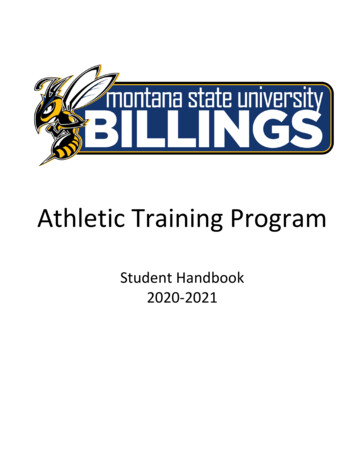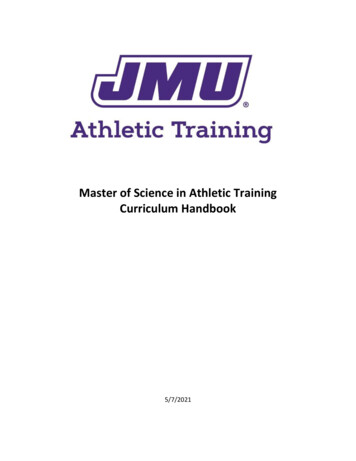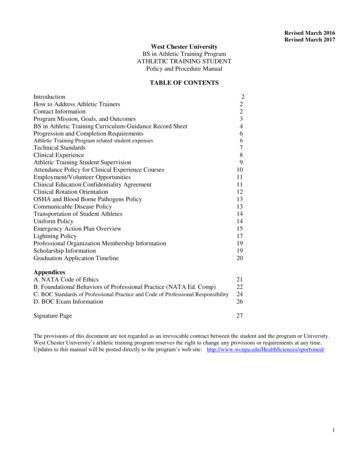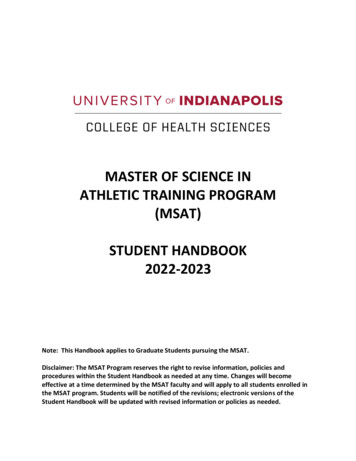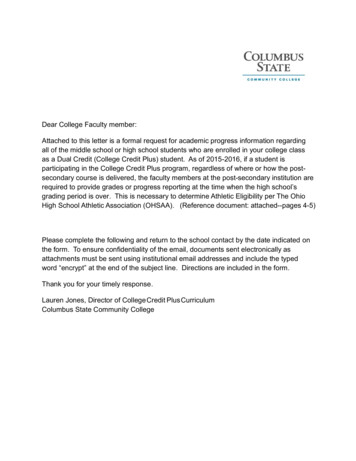
Transcription
Dear College Faculty member:Attached to this letter is a formal request for academic progress information regardingall of the middle school or high school students who are enrolled in your college classas a Dual Credit (College Credit Plus) student. As of 2015-2016, if a student isparticipating in the College Credit Plus program, regardless of where or how the postsecondary course is delivered, the faculty members at the post-secondary institution arerequired to provide grades or progress reporting at the time when the high school’sgrading period is over. This is necessary to determine Athletic Eligibility per The OhioHigh School Athletic Association (OHSAA). (Reference document: attached--pages 4-5)Please complete the following and return to the school contact by the date indicated onthe form. To ensure confidentiality of the email, documents sent electronically asattachments must be sent using institutional email addresses and include the typedword “encrypt” at the end of the subject line. Directions are included in the form.Thank you for your timely response.Lauren Jones, Director of College Credit Plus CurriculumColumbus State Community College
ATHLETIC ELIGIBILTY REPORT FOR DUAL CREDIT (CC ) STUDENTS BY CLASSDirections: District or Middle/High School contacts complete PART A and forward to the College Facultyvia email. Faculty complete PART B and return completed document to the Middle/High School contactand copy the Office of Dual Credit at collegecreditplus@cscc.edu.PART A (to be completed by District/Middle/High School contact and emailed to faculty)School District:Middle or High School:Middle or High School Contact Name:Middle or High School Email:Course Name:Course meeting days/times:Date by which grade reporting is required:List of students for whom grades are requested (add rows as needed):NAMEMIDTERM LETTER GRADENOTE: Contacts are required to request this information electronically using their districtemail address to ensure authenticity of the request. Type “encrypt” at the end of thesubject line.
ATHLETIC ELIGIBILTY REPORT FOR DUAL CREDIT (CC ) STUDENTS BY CLASSPART B (to be completed by College Faculty and emailed to contact above andcollegecreditplus@cscc.edu)Faculty Name:College Name: Columbus State Community CollegeCourse Name:Course Number (ex. ENGL 1100 8090 54321):Letter grade earned by students at grade reporting date as requested:NAMEMIDTERM LETTER GRADENOTE: Faculty are required to report this information electronically using theirColumbus State email address to ensure authenticity of reporting. Type “encrypt” at theend of the subject line.
Guidelines for Student Athletic EligibilityProduced by The Ohio High School Athletic AssociationFor School Counselors – 2019-20Revised 4/1/2019Virtually every scholarship appeal that comes to the OHSAA office places sole responsibility on you, the school counselor, for a student’s failureto meet the requirements of the applicable scholarship bylaws found in 4-4. Even though that notion is fundamentaly incorrect and OHSAA rulesmake reference to the fact that scholastic success is a shared responsibility with parents and students expected to shoulder most of the load, theExecutive Director’s Office has prepared this document to inform you of the crucial information that you need to know in order to advise studentsappropriately.IMPORTANT ITEMS TO KNOWHIGH SCHOOL1. All high school students MUST be enrolled in and earn passing grades in a minimum of five one-credit courses (or the equivalent) eachand every grading period to have continuing eligibility.2. Participate in every effort to ensure that all students are fully scheduled in a minimum of five one-credit courses each grading period.3. If a student comes to you and asks to drop a course, ask the following questions:a. Are you a student athlete?b. What sports do you play?c.Have you visited with your athletic administrator or principal to determine if dropping this course will affect your eligibilityto play a sport?4. Do not allow the student to drop a course which reduces his/her course load below five one credit courses unless you receive a formfrom a senior administrator a template of which can be accessed here. SuggestedScheduleChangeForm.pdf)5. The required Physical Education Course is not a full credit course. Do not count this course as one of the five full credit courses.6. Always contact your principal or athletic administrator if you have any questions.7. The OHSAA has no minimum grade point (GPA) requirement, thus issues regarding eligibility when only the GPA is of concern arestrictly a local school district matter and not an OHSAA matterGrades 7-81. All 7-8th grade students MUST be enrolled in and earn passing grades in a minimum of five courses each and every grading period tohave continuing eligibility.2. Participate in every effort to ensure that all students are fully scheduled in a minimum of five courses each grading period.3. If a student comes to you and asks to drop a course, ask the following questions:a. Are you a student athlete?b. What sports do you play?c.Have you visited with your athletic administrator or principal to determine if dropping this course will affect your eligibilityto play a sport?4. Do not allow the student to drop a course which reduces his/her course load below five courses unless you receive a form from a senioradministrator a template of which can be accessed here. SuggestedScheduleChangeForm.pdf)5. Always contact your principal or athletic administrator if you have any questions.NOTE: “Grading period” is defined as your school’s board-adopted calendar. In most school districts, this is a nine-week period, while some districts usesix- or 12-week periods or semesters. It should also be noted, however, that interim, biweekly or weekly evaluations are not considered “grading periods,”and restoration of eligibility is NOT permitted after such evaluations.In addition, students who have not met the high school or 7-8th scholarship requirement are not “substantively eligible;” and a student whofails to register for enough credit hours, fails a class(es) or drops a class that lowers the student below the requisite number of credits,always has a shared responsibility for this shortcoming thus disqualifying such shortcoming from the “due solely to an administrativeerror” category. Therefore; the administrative error bylaw shall never be used in conjunction with Bylaws 4-4-1 or 4-4-5.Examples of Determining Student Eligibility – Grades 9-12Passing grades must be received in a minimum of five one-credit courses, or the equivalent, in the immediately preceding grading period. Todetermine credit equivalency, multiply full-year courses by a factor of 1; semester courses by a factor of 2; twelve-week courses by a factor of3; and nine-week courses by a factor of 4.SubjectEnglish 10Spanish IHealthAlgebraComputersSocial StudiesTotal CreditsGradeCDBFCCExample 1: 1st Nine-Week Grading PeriodCredit & DurationFactorCredit Equivalency (Must Equal 5 Units or Equivalent)1 - all year11 x 1 11 - all year11 x 1 11/2 - semester21/2 x 2 11 - all year101/2 - semester21/2 x 2 11/2 x 2 11/2 - semester25 eligible for 2nd grading gTotal CreditsGradeCFDBBCExample 2: 4th Nine-Week Grading PeriodCredit & DurationFactorCredit Equivalency (Must Equal 5 Units or Equivalent)1 - all year11 x 1 12 - all year101 - all year11 x 1 11 - all year11 x 1 11/4 - semester21/4 x 2 1/21/4 x 4 11/4 - 4th 9 weeks44 1/2 ineligible for 1st grading period of next school yearPost-Secondary Option – College Credit PlusNote: If a student is taking all course work at the post-secondary institution under the College Credit Plus program, the calculation of equivalency haschanged. Please note that in order for a CCP class to be used for determining eligibility for Bylaw 4-4-1, the class must count toward HS graduation.
In addition, students electing to enroll in CCP must be certain that 1.) The faculty members at the post-secondary institution understand that they will needto provide grades or a progress report at the time when the high school’s grading period is over, and 2.) The student-athlete is taking enough course workat the post-secondary institution exclusively or between the post-secondary institution and the high school combined to be equivalent to five one-creditcourses. Calculating equivalency of credits in the post-secondary institution is conducted in the same manner as in the high school, based on the Carnegieunit. College courses for which three or more semester hours of credit are earned shall be awarded one Carnegie unit. Fractional Carnegie unitswill be awarded proportionately. This means that courses which are four, five, six or even seven hours of credit receive just one Carnegie unit. Examples of gyTotal CreditsSchoolHighCCPCCPCCPExample 1: 1st Nine-Week Grading PeriodCredit & DurationCredit Equivalency (Must Equal 5 Units or Equivalent)1 (year course)1 x 1 13 semester hours1 x 2 25 semester hours1 x2 23 semester hours1x2 27 eligible for 2nd grading period provided all courses passedThe factor of 2 is used for post-secondary institutions that are on the semester system.SubjectFrenchSociologyComputersGeologyTotal CreditsSchoolCCPCCPCCPCCPExample 2: 4th Nine-Week Grading PeriodCredit & DurationCredit Equivalency (Must Equal 5 Units or Equivalent)5 semester hours1 x 2 23 semester hours1 x 2 22 semester hours.67 x 2 3 semester hours1x2 27.34 eligible for 1st grading period of next school yearprovided all courses passedThe factor of 2 is used for post-secondary institutions that are on the semester system. Note that this student is taking all courses at thepost-secondary institution, which is acceptable.Block SchedulingBlock scheduling or double blocking of courses does not change the calculation of credit equivalencies as required in OHSAA bylaws. Coursestaken over one semester or one quarter (9-week period) carry a factor of 2 and 4, respectively. Therefore, if a student takes an English courseduring the first semester only and receives one credit for passing that course, that class carries an equivalency of 2 (1 credit x the factor for asemester course (2) 2). Examples of block scheduling:SubjectEnglish 10Spanish 2HealthTotal CreditsGradeCCBExample 1: 1st Nine-Week Grading PeriodCredit & DurationFactorCredit Equivalency (Must Equal 5 Units or Equivalent)1 - semester21 x 2 21 - semester21 x 2 21/4 x 4 11/4 - 1st 9 weeks45 eligible for 2nd grading periodSubjectCalculusFrenchPhys. EdTotal CreditsGradeBCAExample 2: 3rd Nine-Week Grading PeriodCredit & DurationFactorCredit Equivalency (Must Equal 5 Units or Equivalent)1 - semester21 x 2 21 - semester21 x 2 21/4 x 2 1/21/4 - semester24 1/2 ineligible for 4th grading periodExamples of Determining Student Eligibility – Grades 7-8Passing grades are required in a minimum of five subjects in which enrolled in the immediately preceding grading period. All courses,regardless of how many times per week the course meets, in which a student receives a grade count toward this eligibility requirement.SubjectEnglishMathHome EconomicsComputersMusicHealthCredits PassedExample 1: 1st Nine-Week Grading PeriodGradeFBBCCF4 of 6 classes NOT eligible for 2nd grading periodSubjectEnglishMathIndustrial ArtsMusicComputersPhysical EducationCredits PassedExample 2: 3rd Nine-Week Grading PeriodGradeFDCBBB5 of 6 classes eligible for 4th grading periodNOTE:For additional information, contact:Ohio High School Athletic Association4080 Roselea Place, Columbus, Ohio 43214Office Hours: Monday - Friday 7:30 a.m. - 4:30 p.m.Telephone: (614) 267-2502 Fax: (614) 267-1677 Website: ohsaa.orgThe complete text of the Bylaws and Regulations is published in the OHSAA Handbook, which is mailed to your school each summer and isposted on the OHSAA website.
College courses for which three or more semester hours of credit are earned shall be awarded one Carnegie unit. Fractional Carnegie units will be awarded proportionately. This means that courses which are four, five, six or even seven hours of credit receive just one Carnegie unit. Examples of CCP options: -1- Example 1: 1st Nine-Week Grading .

